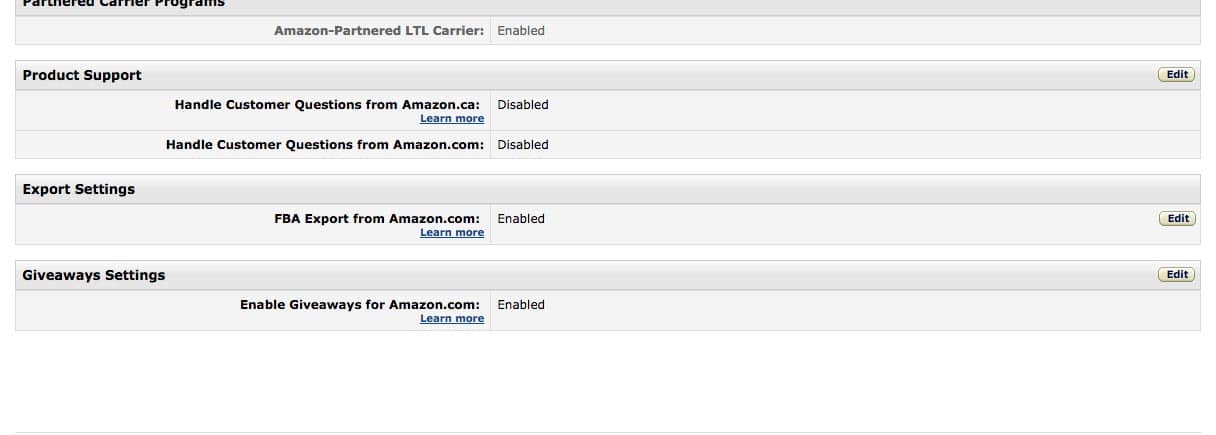In a surprisingly short email sent recently, Amazon told third-party FBA sellers that their products were being offered for sale on more than 100 international markets through the new FBA Export program. Here are the most important facts in summary, and some factors for your consideration regarding this program.
Who can join the international FBA Export program?
![]() Right now, only certain products and categories are eligible. There are myriad restrictions on exports/imports and of course transportation and logistics difficulties that may arise with certain products. You can check in your Seller Central account whether your products qualify, and therefore have been automatically enrolled for international purchase.
Right now, only certain products and categories are eligible. There are myriad restrictions on exports/imports and of course transportation and logistics difficulties that may arise with certain products. You can check in your Seller Central account whether your products qualify, and therefore have been automatically enrolled for international purchase.
Click “Fulfillment by Amazon” in the “Settings” dropdown in your Seller Central account then go to the “Export Settings” group. You can enable or disable FBA Export there in your “Export Settings“.
Any customer shopping on Amazon.com with a shipping address in any of the 100+ countries in the program will be able to purchase FBA Export products.
When was this announced?
On May 15th, 2018 Amazon sent the email to US (.com) FBA sellers.
Are there any risks to the FBA Export program?
Yes and no.
No: Sellers on the .com marketplace will continue to pay standard FBA fees for those products sold globally. So, it’s an added benefit for now that one’s potential customer base has been increased at zero cost to the seller.
Yes: Depending on the country, shipping times could mean a painfully long wait for buyers, and therefore negative seller feedback or reviews (that you may be able to get removed, at some cost of time/aggravation to you).
Also depending on the country, return rates could jump simply due to undeliverability. We’ve personally heard quite a few accounts of delivery mishaps in Europe, for starters:
- Packages arriving before the scheduled delivery time and therefore getting returned to sender
- Packages being given to neighbors when the addressee isn’t at home
- Packages being held at the post office (with limited opening hours) for pickup, and the recipient is notified via postcard rather than postcard AND email, text message, etc.
Your product might become damaged in transit and either returned, or you might offer a (partial) refund as compensation. That hurts the health of your seller account, your ranking (eventually), and also your bottom-line profits.
Think Twice About the FBA Exports Program Before You Enroll
We’ve had the pleasure of having in-depth, primary contact with sellers on North American and European markets. Some live in those respective areas, and some do not. It’s given us valuable insights into exactly what kind of unexpected difficulties might arise when expanding globally beyond Amazon.com.
US sellers should be warned about the following disadvantages Europe offers, depending on the country and courier:
- Longer delivery times
- Returns due to undeliverable packages after 1 or 2 weeks, depending on the country
- Possible hassle from customs agents collecting tax from the recipient, which only happens conveniently upon delivery if you’re a business customer using FedEx; otherwise, the norm is to make the recipient travel to the local customs office to pay duties and pick up their parcel.
- More negative reviews and detailed complaints
- Strikes, “excessive” bank holidays and more time off can further delay logistics
FBA Export vs. Selling on International Marketplaces
If you scroll to the bottom of Amazon’s FAQ page on the subject, you’ll notice that Germany, France & co. have been included in this scheme.
Remember, the FBA Export program isn’t internationally selling, so your products won’t appear on Amazon.de or Amazon.fr. They’ll be found on Amazon.com and shipped to Germany or France respectively. If you were listed on those marketplaces, that would entail considerably more effort on your part as a US-based or US marketplace seller:
- Translations of listings, customer contact templates and customer support inquiries
- Collecting and filing VAT / sales tax in each respective country you’re selling on. Remember that you can enroll in Amazon’s VAT services, but they aren’t currently accepting new registrations.
Inside Amazon’s Mind: Why International Export for Prime?
It seems that this step puts Amazon even closer to simply breaking down international walls and selling products where ever they’d like. Though they’re eager to out-grow competitors in the ecommerce field, they are probably not seeing the growth they so desperately seek.
Amazon’s growth in EU marketplaces could be hampered by a few reasons, in order of their priority: hassle with shipping couriers / delivery services, hassle with VAT registry, relatively low sales volume compared to the .com marketplace and last but not least, difficulty EU citizens have in starting a business. There’s much more paperwork and time involved than in the UK and USA. It’s become such a barrier for Europe opening up to business and freer trade of services / labor that Estonia stepped up to the plate to solve this problem with e-residency.
It might be a wise idea to count yourself out as an early adopter, and wait to see how other .com sellers fair with the international FBA Exports.
How to Un-Enroll from the Amazon FBA Export Program
Step 1
To exclude your products from FBA Export, log into Seller Central and click “Fulfillment by Amazon” in the “Settings” drop-down menu.

Step 2
Go to the “FBA Export” section as seen in the screenshot below.

Step 3
In the “Export Settings” group, click “Edit” to switch this to “Disabled“.

You can also do this via flat-file if you have lots of products.
If you’re interested in selling internationally, learn more about selling on Amazon EU.


